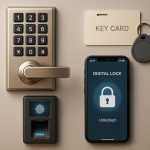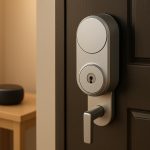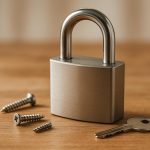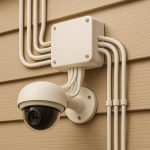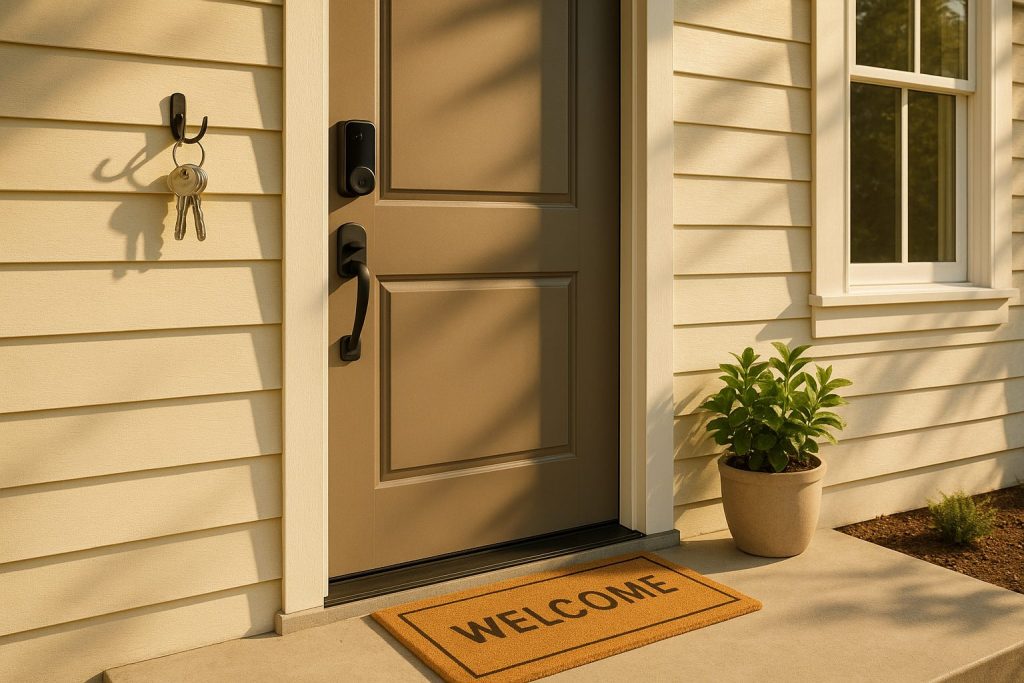Getting locked out of your home is a hassle that can disrupt your day and even put you at risk. But the good news? It’s avoidable. Here are six simple strategies to prevent lockouts:
- Spare Keys: Store duplicates securely – give one to a trusted person, use a lockbox, or hide it in an unconventional spot.
- Smart Locks: Install keyless entry systems, like numeric keypads, fingerprint scanners, or smartphone-controlled locks, to eliminate physical keys.
- Daily Habits: Always check for keys before leaving and designate a consistent spot for them near your door.
- Lock Maintenance: Regularly clean and lubricate locks to keep them functioning smoothly.
- Emergency Planning: Save a locksmith’s contact info and ensure everyone in your household knows what to do during a lockout.
- Professional Inspections: Annual checkups by a locksmith can catch potential issues early.
Make a Lock Out Plan to Avoid Serious Issues #homeownership
Make and Store Spare Keys
One of the easiest ways to prevent being locked out of your home is by having spare keys ready. However, where and how you store those keys is just as important as having them in the first place.
Safe Spare Key Storage Options
Give a spare key to someone you trust. A nearby neighbor or family member can be a lifesaver in an emergency. Just make sure it’s someone you can rely on and who’s close enough to help when needed.
Install a key safe or lockbox. These sturdy, weatherproof boxes can be mounted outside your home and secured with a combination lock. Place the lockbox in a discreet but accessible spot to keep it out of plain sight while still easy to reach.
Consider hidden key containers. If you decide to hide a key on your property, steer clear of obvious spots. Think beyond the usual hiding places and pick a location that’s less predictable. But remember, this should only be a backup option – trusted individuals or lockboxes are far safer.
These strategies can help you avoid the hassle of a lockout while keeping your home secure.
Skip Obvious Hiding Places
Avoid hiding keys in places that burglars are likely to check first. Spots like under doormats, flower pots, fake rocks, mailboxes, or porch furniture are well-known and risky. If you must hide a key, pick an unusual location far from your home’s entrances and make it a habit to change the spot occasionally.
Key Duplication Services
When it comes to making spare keys, leave it to the professionals. Sherlock’s Locksmith offers reliable duplication services for all kinds of residential locks, including more secure options. Always bring the original key for duplication – copies of copies can wear down over time, leading to issues. A professional locksmith can also help you decide how many spares you actually need, ensuring you’re prepared without going overboard.
Install Smart Locks or Keyless Entry
Smart locks and keyless entry systems make life easier by eliminating the need for traditional keys. They reduce the chances of getting locked out and add an extra layer of security to your home. Let’s take a closer look at the different types of keyless entry options available.
Types of Keyless Entry
Numeric keypads
With numeric keypads, you simply enter a code on a sturdy keypad to unlock your door. They’re especially convenient for families since you can assign unique codes to each member and update them whenever needed.
Fingerprint scanners
Fingerprint scanners rely on your biometric data for access. All you need to do is scan your finger to unlock the door. These systems often support multiple fingerprints, making them perfect for households with several residents.
Smartphone-controlled locks
These locks pair with your smartphone via Bluetooth or Wi-Fi, letting you unlock your door with just a tap. Some models even allow you to send temporary digital keys to guests, giving you more control over who can enter and when.
Combination systems
Combination systems integrate two or more access methods, such as combining fingerprint recognition with smartphone control. This dual approach offers a reliable backup in case one method isn’t available.
Security Advantages
Keyless entry systems are generally harder to pick or duplicate compared to traditional locks. Many models come with features like automatic re-locking, so you don’t have to worry about accidentally leaving the door open. Plus, activity logs and temporary access codes make it easy to track who’s coming and going or to grant short-term access when needed.
Professional Installation
For a seamless experience, consider professional installation services like those offered by Sherlock’s Locksmith. Their experts start with a thorough security assessment and ensure your doors are compatible with the chosen system. They handle every detail of the installation process, from wiring to secure network setup, and test the system to guarantee it works flawlessly. This ensures that any potential hurdles, like tricky wiring or compatibility concerns, are dealt with effectively, leaving you with a reliable and secure setup.
Build Daily Key Habits
Developing daily habits around your keys can save you from the frustration of lockouts. Instead of relying on memory – especially during hectic mornings – establishing consistent routines makes a world of difference.
Check for Keys Before Leaving
Get into the habit of checking for your keys every time you step out the door, just like you instinctively check for your wallet or phone. To make this easier, create a dedicated spot near your main exit where your keys always go. This could be a small bowl on a table by the door, a hook on the wall, or a key rack mounted near the entrance. The idea is to place your keys somewhere natural and convenient as you come home.
Many people find it helpful to keep their keys alongside other daily essentials, like their purse or briefcase. When everything has a designated place, you’ll always know where to look. To reinforce this habit, try repeating a quick mental checklist – “keys, wallet, phone” – before you leave.
Once you’ve established a routine, you can add reminders to help lock in the habit.
Use Reminders
Reminders, both physical and digital, can give you an extra safety net when you’re in a rush. A sticky note on your front door or car dashboard with a simple question like “Got your keys?” can be a lifesaver. You can also set smartphone alerts a few minutes before your usual departure time to gently prompt you.
For a more tech-savvy solution, consider using Bluetooth key trackers. These devices pair with your phone, making it easy to locate your keys if they go missing. Another trick? Attach your keys to something you always carry, like your car keys or a brightly colored keychain that’s hard to overlook.
Instruct Your Household
If you share your home with others, it’s important that everyone follows the same system. Establish clear rules about where keys should be kept and ensure everyone sticks to the plan. Research suggests it can take around 66 days to form a new habit, though some routines can take hold in as little as three weeks with consistent effort. Whether it’s family members or regular visitors, make sure everyone is on the same page to avoid confusion and prevent lockouts.
sbb-itb-643e28e
Maintain Your Locks Regularly
Taking care of your locks on a regular basis helps them work smoothly and reduces the risk of lockouts caused by mechanical issues.
Basic Lock Care
To keep your locks functioning properly, it’s a good idea to lubricate them every six months. Use a Teflon-based or dry lubricant specifically designed for locks – steer clear of oil-based greases, which can attract debris and cause more harm than good.
"Repairmen and door locksmiths recommend avoiding oil-based greases." – The Doors Depot
Teflon-based and dry lubricants are preferred because they’re easier to use and collect less dirt compared to graphite lubricants. When lubricating, apply a small amount directly into the keyway. Insert your key without turning it, remove it, and wipe away any grime that sticks to it. Repeat this process a few times to clear out built-up dirt. Afterward, spray a little more lubricant and turn the key several times to ensure it’s evenly distributed. Don’t forget to also lubricate the bolt, keyhole, and strike plate once a year.
It’s important to keep the keyhole clean and free of debris. Make it a habit to clean the door and its frame regularly as well. If you notice your lock becoming sticky or difficult to turn, it’s a sign that it may need cleaning or lubrication.
By following these simple steps, you can keep your locks in good working order and reduce the likelihood of needing emergency repairs.
Schedule Professional Inspections
While regular maintenance goes a long way, having a professional locksmith inspect your locks annually can help catch hidden issues like wear, alignment problems, or internal damage before they turn into bigger problems.
"Proper maintenance can save you from calling an emergency locksmith service." – Armstrong Locksmith Inc.
Professional inspections are especially valuable for older locks or homes where locks see heavy use. During an inspection, a locksmith can adjust strike plates, tighten screws, check door alignment, and identify parts that may soon need replacement. For standard residential locks, aim for an annual inspection – or more frequent checkups if you notice any changes in how your locks operate.
This proactive approach not only keeps your locks in top shape but can also save you money by avoiding costly emergency services.
Plan for Lockout Emergencies
Lockouts are a frustrating reality, no matter how cautious you are. A dead phone battery, a broken key, or simply forgetting your keys can leave you stranded outside. But with a little preparation, you can avoid unnecessary stress and costly mistakes.
The secret to managing lockout emergencies is being prepared. Lockouts can cloud your judgment, making it harder to think clearly. Having a plan in place ensures you’ll know exactly what to do and who to call, making the situation easier to handle.
Save Locksmith Contact Information
The first step in preparing for a lockout is saving the contact information of a trusted locksmith. For example, keep Sherlock’s Locksmith’s phone number stored in multiple places so you can access it even if your phone is unavailable.
Here’s a tip: save the locksmith’s number in your phone under an easy-to-find name like Emergency Locksmith. But don’t stop there. Write the number down and keep it somewhere accessible – like in your wallet or taped inside a drawer at home. If your phone is locked inside or out of battery, a physical backup can save the day.
Another smart move? Write down your home address alongside the locksmith’s contact info. Stress can make even the simplest details – like your own address – hard to recall. Having it written down ensures you can quickly and accurately relay your location when calling for help.
Once you’ve secured the contact details, make sure everyone in your household knows the steps to take during a lockout.
Teach Emergency Steps
Preparation doesn’t stop at saving a number. Everyone in your household, from kids to adults, should know what to do if they’re locked out. Clear instructions can prevent panic and help resolve the situation faster.
Start with the basics: never try to break a window, force a door, or climb through an opening. These actions can lead to injuries or costly property damage. Instead, the first step is to stay calm and assess the situation.
Create a simple checklist for emergencies:
- Double-check all doors and windows to confirm you’re locked out.
- Look for spare keys in designated spots.
- If no access is possible, call the locksmith using the saved number.
For families with children, practice emergency scenarios. Teach kids how to state their full address and a parent’s phone number so they can communicate clearly if needed. Regular practice helps younger children retain this information, even during stressful moments.
Teenagers and adults should also understand the importance of staying nearby while waiting for help. Wandering off could delay the locksmith’s arrival or create additional safety concerns.
For families with younger kids, consider setting up a neighbor contact system. Identify two or three trusted neighbors who are usually home at different times of the day. Teach your children which houses they can go to for help and how to explain the situation. This gives them a safe place to wait while you handle contacting the locksmith and coordinating the response.
Conclusion
Avoiding a lockout is easier than you might think. By taking simple steps like keeping spare keys handy, installing smart locks, building consistent key habits, maintaining your locks, and preparing for unexpected situations, you can significantly reduce the chances of being locked out.
Using a mix of these strategies offers extra peace of mind. For instance, storing spare keys in a secure spot, opting for a keyless entry system, and sticking to daily routines can provide a solid safety net.
It’s always smarter – and cheaper – to prevent a lockout than to deal with one after it happens. Spending just 30 minutes to create a backup plan, like programming a smart lock or setting up spare keys, can save you a lot of time and money in the long run.
And if the unexpected does happen, Sherlock’s Locksmith has you covered. They’re available 24/7 for emergency lockouts, security system installations, and expert lock services to ensure your home stays secure and accessible.
Take action today to protect yourself from the hassle of a lockout. A little preparation now can make a world of difference later.
FAQs
What are the safest ways to store spare keys while keeping your home secure?
When it comes to storing spare keys, safety and discretion should be your top priorities. One of the best options is using a lockbox or key safe. These secure devices can be mounted in a hidden yet accessible spot on your property and are only accessible with a specific code or key, offering peace of mind.
Steer clear of predictable hiding spots like under the welcome mat, inside flower pots, or above door frames – these are the first places anyone with bad intentions is likely to look. If a lockbox isn’t your style, consider handing over a spare key to a trusted neighbor or family member. This way, you’ll have access when needed without putting your home at risk.
For a more modern solution, you might want to look into smart locks or keyless entry systems. These allow you to unlock your home using a secure PIN or a smartphone app, eliminating the need for a physical key altogether.
What are the differences between smart locks and traditional locks when it comes to security and convenience?
Smart locks bring modern convenience to the table with features like keyless entry, remote access, and activity tracking. Imagine locking or unlocking your door from anywhere – whether you’re at work, on vacation, or just cozy on the couch. Plus, you can keep tabs on who’s coming and going. Most smart locks also come with advanced encryption to boost security. However, they do depend on power sources like batteries or Wi-Fi, which means you’ll need to stay on top of maintenance to avoid any hiccups.
Traditional locks, by contrast, are all about simplicity and dependability. They don’t rely on electricity or internet connections, so you won’t have to worry about technical glitches or dead batteries. That said, they don’t offer the perks of remote access or activity tracking.
Both options have their pros and cons, so it really comes down to what matters more to you: the convenience of modern tech or the no-frills dependability of a classic lock.
What can I do if my lock feels stiff or hard to turn, even with regular upkeep?
If your lock feels stiff or tough to turn, it’s often caused by rust, dirt buildup, or internal misalignment. A good first step is to clean the lock thoroughly and apply a lock-specific lubricant, such as graphite spray, directly into the keyhole. Steer clear of oil-based lubricants – they tend to attract dirt and can make the problem worse over time.
If cleaning and lubricating don’t solve the issue, the lock might need to be taken apart to inspect for worn or damaged components. In some cases, it might be easier and more reliable to replace the lock entirely. To avoid these problems in the future, make it a habit to clean and lubricate your lock regularly to keep it working smoothly.



